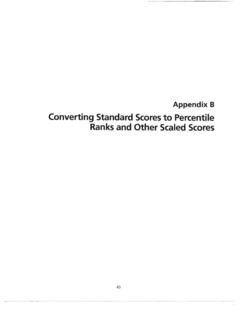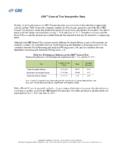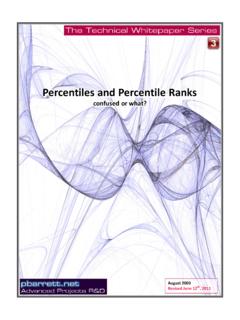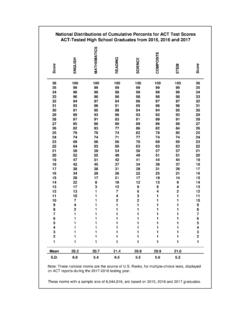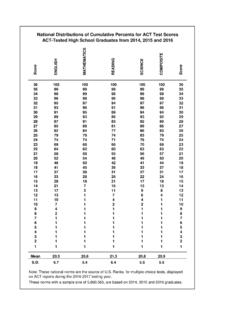Transcription of Stanford 10 Test Interpretation
1 Stanford 10 Test Interpretation The Stanford Achievement Test, Tenth Edition ( Stanford 10), was administered to WCCS students in Grades 2-8. The Otis-Lennon School Ability Test, Eight Edition (OLSAT 5), the companion school ability measure for the Stanford 10, was administered in Grades 2-4 and 8. This Interpretation guide outlines how to interpret a student report in a manner consistent with the purposes of these assessments. The Stanford 10 is an untimed, standardized, norm-referenced test where the conditions ( time limits, directions) remain the same for each child who takes the test.
2 A norm-referenced test compares a student s results with the results from a national sample of students in the same grade level taking the test at the same time of year. Although the content of the Stanford 10 includes academic concepts and skills typically taught in the US, it does not necessarily match the WCCS curricular standards for each grade level. Primary Purposes of the Stanford 10 To test students knowledge of facts, basic skills, and concepts common to the grade level To compare individual performance with performance of the norming group To report relative strengths and weaknesses of individuals To provide data for studying changes/progress in performance over time To evaluate students ability to apply thinking skills Key Areas of Interest GrdPR or PR to identify where your student ranks nationally Total Reading.
3 Math and Language scores Complete Battery (full-length versions of all subtests) Basic Battery (a subset of items from all Complete Battery subtests, except Listening) Otis-Lennon Total to identify where your student ranks in school ability Explanation of Reported Scores Norm-Referenced Scores Scaled Scores (SS) National percentile ranks (GrdPR or PR) National Stanines (ST9) Grade Equivalent (GE) Lexile Framework for Reading (LEXILE) Achievement/Ability Comparison Range (AAC) Number Correct Scaled Scores (SS) describe a student s location on an achievement continuum, a continuously running scale that ranks the lowest scores on one end (to the left) and the highest scores on the other end (to the right).
4 These scores may be used to note your student s growth from year to year as measured by achievement testing. Rising SS scores show that growth has probably occurred, though the rate of growth will vary. National percentile ranks (GrdPR or PR) range from a low of 1 to a high of 99, with 50 denoting the national average. A percentile rank tells the percent of students in the norming group who got the same raw score or a lower raw score on the test. A student earning a percentile rank of 65 performed as well as or better than 65% of the students in the norming group.
5 Unlike percentages, percentiles should be viewed as approximate rather than specific values. A five to eight point variance from year to year is likely immaterial. National Stanines (ST9) range from a low of 1 to a high of 9, with 5 denoting the national average. Stanines 1, 2, and 3 are below average; 4, 5, and 6 are average; and 7, 8, and 9 are above average. Grade Equivalent (GE) scores can be helpful in measuring academic growth from year to year. The number in front of the decimal represents the grade year, and the number after the decimal represents the grade month.
6 For example, if a second grade student scored a GE of , it means that the student earned a score equivalent to what a typical student in the seventh month of fourth grade would make. It does not mean readiness for fourth grade material; however, it means only that the student has a thorough mastery of the material covered on the second grade test. Lexile Framework for Reading (LEXILE) is a reading measurement that matches readers to For more information refer to The OLSAT 8 is a measure of school ability. The national grade percentile rank and stanine (PR-S) indicate how a student performed on the OLSAT8 compared to students in the norming group who were in the same grade.
7 The Ability/Achievement Comparison (AAC) range indicates the relationship between a students s score on the Stanford 10 and the scores of other students of similar school ability in the norming group as measured by the OLSAT 8. If a student s achievement score is in the top 23% when compared to students of similar ability, the AAC is HIGH. If the achievement score is in the middle 54% when compared to students of similar ability, the AAC is MIDDLE. If the achievement score is in the bottom 23% when compared to students of similar ability, the AAC is LOW.
8 Number Correct indicates how many times a student answered correctly in relation to the number of questions.



